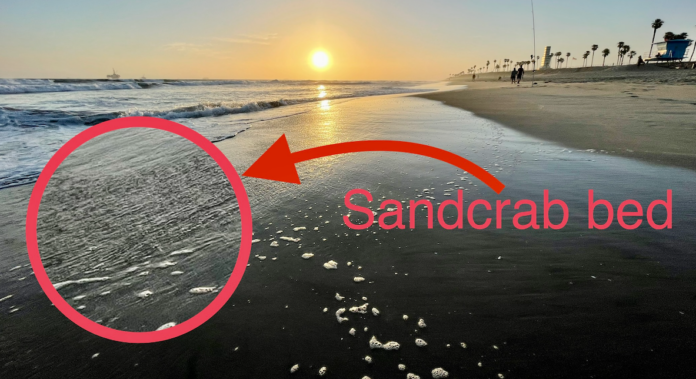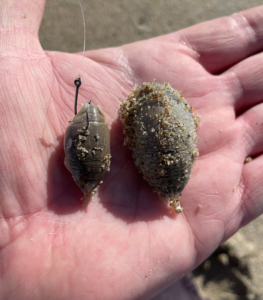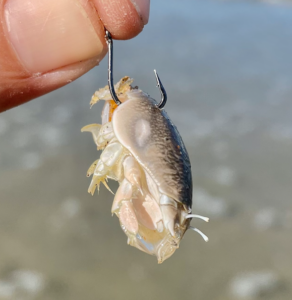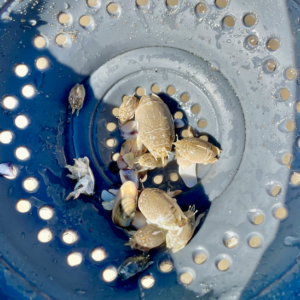
BY BEN HERVEY-MURRAY
The diminutive sand crab is a cornerstone of the marine ecosystem on the West Coast with almost everything eating these little crustaceans, or preying on something that eats them. They’re one of the best baits for catching anything that swims, but hunting sand crabs is in itself a bit of an art. Here’s what you need to know to access near-unlimited free surf fishing bait this season!
- Sand crab basics
Sand crabs – also known as sand fleas, mole crabs or sand bugs – are small clawless crustaceans that bury themselves in sand with just their hairy little antennae protruding above the sand to filter-feed on plankton washing over their heads as the waves pull back and forth. They live in the swash zone, for the most part, and usually form small colonies visible as areas of disrupted sand as the water pulls back.
On the West Coast, the Pacific sand crab (Emerita analoga) is found most of the year-round but becomes a lot harder to locate when the water temperature falls below the 60s. This means that the winter months are less productive for sand crab hunting, but some can still be found, usually around solid structure (jetties, breakwaters and piers) It’s also worth trawling the shore break area with a large sand crab rake for winter overstayers if it’s cold. There are usually a few hardy ones left, even in the depths of winter.

Throughout spring, summer and fall, the best way to find sand crabs is to look for the visual clues they give off as they work their way up and down in the sand; first poking their antennae and top half of their body out to collect food, before burrowing down as the water retreats. Imagine an upside-down egg box buried in the sand with the domes just poking out, and how water flowing over the top of the little bumps would be disrupted and the sand around the bumps would move differently, creating little V shapes and ripples. This is how a small colony of medium to large-size crabs looks as a water retreats. Smaller sand crabs, from grain-of-rice to pea-size, often form large colonies in the same way but are less visible due to their size. They’ll often appear as a patch of dark dots in the sand.
Other things to look out for are egg-carrying crabs, identifiable via the orange blob of eggs lodged in their rear end, and soft shell crabs which are in the process of molting their shell. Both are considered to be exceptional baits.
2. Tides
With the sand crabs mainly inhabiting the shore break area, tides become really important and I’ve found specific tidal states to be more productive than others. The two states of tide I want to be hunting crabs on are either a very low or minus tide, or during the middle of an outgoing or incoming tide, right between the high and low marks.

Generally, I’ve found a high tide to not be as productive for crab hunting as I suspect the areas they like to inhabit are, at this stage, covered by water and not visible to us. This may be because often at the high tide mark you get a collection of rocky, coarse sand propelled up the beach to the top of the surf line by the incoming tide, and sand crabs show a clear preference for clean, soft sand, found below the tide line, that they can dig into easily. The exception to this rule is often found alongside a jetty or pier, where they seem to be happy whatever the state of tide or temperature, often tucked right alongside rocks or pilings in soft, waterlogged sand.
3. Capture methods
The three main methods I use to catch sand crabs are by hand, with a kitchen strainer (the type you’d use to drain boiled pasta) and with a large sand crab rake. The universal rule for all three is this: timing is key.
With the crabs poking their heads out most just when the waves retreat, timing your scoop or grab to coincide with the moment when only an inch or two of water remains whilst rapidly draining out offers the best chance of a scoop-load. If you wait until the water has all gone, the crabs will likely have buried themselves surprisingly far down in a second or two. Catching by hand is great if you just want one or two for a hook bait. The rake is a great option for when you need a day’s worth of bait – one scoop in the right place and you won’t have to do any bait collecting for the rest of the day. But the pasta strainer is probably the easiest method to use and takes up little room in a bag.

Procedure-wise, once I’ve spotted the bed of crabs via the disrupted sand in the shore break area, I’ll first make sure to keep several meters away from the bed. This is because sand crabs are easily spooked (as you would be if everything wants to eat you) and any sort of shadow or figure looming over them will cause them leave their sandy hole and swim for safety. Once I’m sure there’s a good bed of crabs (and they’re not sand clams or discarded shells etc) I’ll point at the area with my spare hand so I don’t lose track of where they’re sat – something that’s easily done when a wave comes in and covers the area.
With their home patch marked with my pointing hand, I’ll wait until the wave starts to retreat before making a swift incursion into the water, positioning my scoop just downstream of where the crabs are. Using a scooping motion, and taking a divot out of the sand like you’re serving ice cream, execute a swift movement down into where you’ve marked the crab bed so you take the top couple of inches of sand that contains the feeding crabs, filling the scoop entirely. Now carefully wash the sand out with more water provided by the next wave like you’re panning for gold, taking care not to let them escape out of the top as they sense water moving and make a swim for it. With some careful washing, you should reveal a collection of sand crabs in the bottom of the scoop.
The only difference between using the smaller scoop and the large rake is this: instead of scooping out a divot of sand right where the crabs are sat as I enter the water, I position the rake a foot or two downstream of the crab bed, and whilst holding the rake in position I disrupt the bed of crabs with my feet as the water retreats, causing them to pop out of the sand and wash straight into the waiting rake. You can easily catch a few dozen this way, so be careful of breaking the 50-crab bag limit rule.
4. Storage
The best way to store crabs is in a small, well-aerated bait box with a handful of damp sand and a little damp kelp for cover, or in a ziplock bag containing the same. They’ll stay fresh for hours if you keep them cool and damp, and I’ve had some success with keeping them in a fridge in a shallow sand-filled tray for a day or two.
But, generally, I only want to store them for a few hours before throwing the rest back into the surf when the day is done. During summer when they’re really easy to find, and on solo sessions, I’ll simply store a handful in my top pocket and replenish this with a couple more when I see them in the sand. No need to collect more than you need.
5. Crab bed fishing
When crabs are present, there’s no better place to start fishing than in the shore adjacent to the bed. Species like surfperch, corbina, shovelnose guitarfish, croaker, sharks and rays will work this area very precisely, with the surprisingly-mobile sand crabs frequently moving in and out of the swash area and right into the waiting mouths of those eager predators. So, as well as collecting bait when you see the crab beds, make sure you fish the same areas and I promise you’ll find a stack of fish waiting for an easy meal. One thing to consider is that sand crabs are highly mobile and will easily swim off if spooked, only to take up position a few meters down the beach. Keeping mobile often helps to stay in touch with the fish and bait.
By the way, I much prefer two or three small crabs on a size 4, 6 or 8 hook versus a larger offering for targeting general surf species. Those big, grape-size crabs are interesting to look out but don’t cast well and have a tendency to be short-bitten so you reel in just a head or empty shell. A basic Carolina or dropper loop rig on 6- to 15-pound fluorocarbon works great, too. There is no better fresh bait than sand crabs during the warmer months and they’re free, so ensure you make the most of this bountiful bait supply.


